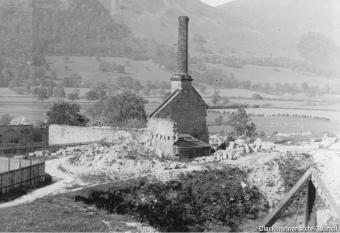Devon Iron-works was an extensive establishment near the left bank of the river Devon, two and a half miles NNE of Alloa, near to what came to be known as the village of Fishcross. With two furnaces and a large foundry, it turned out some thousands of tons of pig-iron each year and converted a considerable portion of this into cast-iron goods.
In the late 1790's it was hoped that the Iron-works would flourish in the area and that the river Devon would be made navigable at least to service this facility. However, the waggonways, and eventually the railways, took up the transport needs of the works such that the canal project was not required. Coal and Iron-stone were hewn at the adjoining Devon Colliery. The demand for coal by the Iron-works was such that almost no coal from the Colliery was sold or transported elsewhere when the works was operating fully.
A waggonway ran from the Devon Ironworks to the Harbour at Clackmannan Pow, and another waggonway ran from the Devon Colliery to Alloa Harbour. Later these were linked together, after Clackmannan Pow closed. Each of these two networks had extensive branches leading to pits at Coalsnaughton, Gartmorn, Gubber Hill, Whinhill and Grassmainston and had numerous connections to the main line railway system.
1792 Works started by Messrs John Roebuck and Thomas Longridge; the furnaces were cut into the solid rock and had a lining of fire-brick; the works also had the largest air vault ever used at an ironwork for blast, also excavated out of the solid rock. The Devon Iron Company's business also included coal mining and distribution.
1794 John Roebuck sold his share to Mr Casamayor and others.
1794 July 17th. John Roebuck died.
1800 Charles Addison and Edward Addison sold the business to Thomas Longridge. Lord Cathcart was the landowner.
1803 Thomas Longridge dies, leaving his estate to his son, George Henry Longridge.
1825 'At Calder iron-works there are four blast furnaces; in Wilsontown, two; in Carron, five; Clyde, two; Shotts, one; Clelland, two; Muirkirk, three; Devon, two. These furnaces make, on an average, thirty-five tons of iron week each, when working.'
1829 Devon Iron Company builds the Chinese Bridge, Taymouth Castle, Perthshire.
'At Devon Iron-works, there has been cast an iron bridge, for the Earl of Breadalbane, to be thrown over the Tay, opposite to Taymouth Castle, it is beautifully light and elegant in appearance. It consists of three arches, the whole embracing a span of about 170 feet.'

Chinese Bridge - Taymouth Castle - Image from Canmore.org.uk
1832 'The subscriber has ceased, since the 23rd March last, to be a partner of Devon Iron Company, and to have any concern or interest in the Devon Iron Works, near Alloa. - George Henry Longridge.
1839 In the early days following the discovery of ironstone in Cleveland, Mr. D. Nesham , of Nesham and Co., of the Portrack Lane Iron-works, at Stockton-on-Tees, was made aware by Mr H. Vansittart (of Kirkleatham Hall) to some ironstone near Coatham, and after examination, he shipped a small cargo to the Devon iron-works for trial. In response he received a letter advising him that it was not worth trying, there being no iron in it. He replied thereto, leaving himself in the manager's hands (Leslie Meldrum). 'And so, on Mr. Nesham having occasion to be in that district about 1850, he, on enquiry, found his cargo deposited in the ballast heap; of course, it had never been tried.'
1843 Alloa Coal Company take over the coal mining attached to Iron works.
1848 '...deceased - Leslie Meldrum, sometime Manager of the Devon Iron Works, near Alloa. Devon Iron Co...'
1849 In March that year, Alexander Christie becomes proprietor of the Iron Works.
1853 Alexander Christie sells the works to his brother, Andrew.
1857 James Miller of Glasgow becomes proprietor of the Iron Works.
1860 Mr Miller dies, iron works sold to persons connected with Alloa Coal Co.
The works closed around 1861.

Devon Iron works partially demolished - picture from Clackmannanshire Council
References
The Statistical Account of Scotland
Canmore.org.uk
